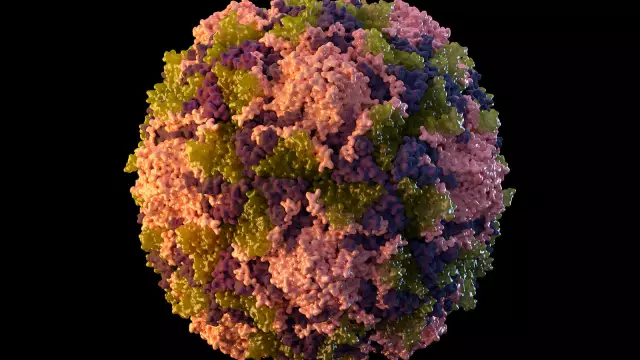- Author Curtis Blomfield [email protected].
- Public 2023-12-16 20:44.
- Last modified 2025-01-23 17:01.
The dangerous polio virus that causes spinal paralysis (another name is Heine-Medin's disease) affects the gray matter of the spinal cord and the motor nuclei of the brainstem. This disease leads to deformation of the limbs and partial immobilization. Let's get acquainted with the general information about this disease. After all, the symptoms of polio need to be known even now, in the age of vaccinations.

How infection occurs
The virus enters the body through dirty hands. The incubation period lasts up to three weeks. During this time, the virus multiplies in the thickness of the oral mucosa and gastrointestinal tract. During this time, there are no symptoms of polio, but the person is a carrier and can infect other people throughout this period. Some patients are faced at this time with a lesion of the nervous system. Most infected people feel the first symptoms of polio only at the end of the incubation period, whenthe virus enters the lymphatic system and then into the blood. Next, the pathogen enters the nervous system, crossing the blood-brain barrier. That is why the disease in question is so dangerous for children. After all, hitting the nervous system, it interferes with normal development. The most vulnerable child is under four years old. Timely vaccinations (the first - at the age of three months), and then revaccination of poliomyelitis can today prevent a disease that leads to disability. But before this disease was one of the most terrible diseases of an infectious nature.
Polio symptoms

There are several forms of this disease. They vary greatly in severity. There is a failed poliomyelitis - in the event that the body's immune response destroyed the pathogen in the incubation phase. The non-paralytic form is the initial one. She is characterized by general malaise, slight fever, dyspepsia, muscle and headaches. All these manifestations disappear in a couple of weeks and can later develop into a paralytic form. The latter is the most severe and bears the most terrible consequences. Immediately after the end of the incubation period, convulsions and characteristic pains appear, due to which muscle weakness occurs. In the future, this form of poliomyelitis progresses sharply. Lethargy grows, reflexes become first elevated, and then disappear. Patients complain of convulsions and paresthesias (impaired sensitivity of the limbs, numbness, tingling). Partial

paralysis of the arms and legs occurs for several weeks, and then disappears, leaving significant deformities and atrophy. Many who recover from polio become disabled later.
Meningeal, spinal, encephalitic, sweating and bulbar forms of poliomyelitis should also be mentioned. The latter has a high mortality rate.
Treatment
There is still no specific cure for polio. Patients are isolated in a hospital for up to forty days. At this time, the affected limbs are treated symptomatically. During the recovery period, a lot of time is devoted to physiotherapy exercises, massage.






